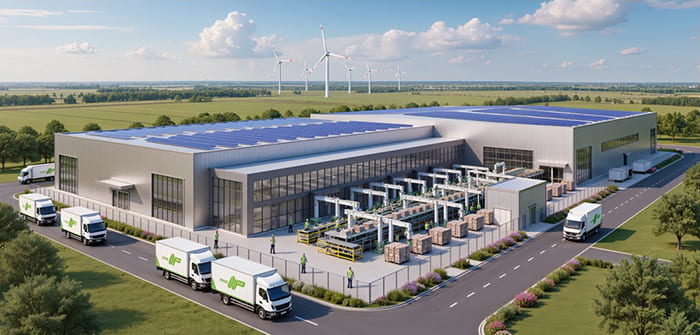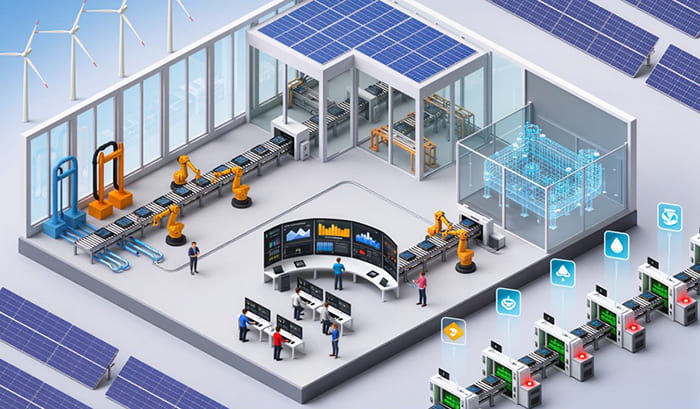- Home
-
The "Green" Future of Solar: How to Achieve Low-Carbon Manufacturing in PV ProductionOCT. 21, 2025
While "sustainable manufacturing" was the overarching term in the PV industry, its environmental subset—"green manufacturing"—has now become the operational priority.While "sustainable manufacturing" was the overarching term in the PV industry, its environmental subset—"green manufacturing"—has now become the operational priority.
Though many people enjoy solar modules for the clean power that they produce, few consider the enormous amount of energy, water, and raw materials that go into producing them. To put it simply, To put it simply, if the manufacturing process itself is highly energy-intensive and consequently generates substantial carbon emissions, then solar power cannot be truly considered a clean energy source.
For actors in the PV industry, it is not only a question of environment but also of strategic positioning in the market, criticial to customer satisfaction and investor trust. How then, could a PV factory maintain high levels of productivity whilst "going green”? This can be simplified into three: energy efficiency, material utilization, and smart factory management.
Within a factory, "green” in energy efficiency is at the heart of the system.
Consider a factory that runs a production line that stretches hundreds of meters in length and runs twenty-four hours a day for every day of the month and the year, and is powered solely on electricity from the convention grid. This model of operation inevitably results in substantial energy consumption and carbon emissions. Thus,” The first step toward real sustainability is switching to clean energy and improving equipment efficiency
This can be achieved through practices such as:
Self-generated green power systems where leading PV companies install pieces of equipment such as rooftop solar and storage systems to power their own factories, and last but not least high-efficiency equipment, in most cases, next generation furnaces.
High-efficiency equipment: Next-generation furnaces, laminators, and dryers consume significantly less energy per wafer or module produced.
Waste heat recovery: Capturing heat from high-temperature processes and reusing it reduces both costs and carbon emissions.
These steps not only cut carbon emissions but also give manufacturers an edge—since more and more customers now factor ESG performance into supplier selection.

Material Utilization: Accounting for Each Single Gram
In PV production, raw materials such as silicon, silver paste, EVA, and glass are also expensive and valuable. The second key to low-carbon manufacturing is to "use less, recycle more”.
Thin wafer technology: Saves thinner lithographed silicon wafers significantly more.
Precise printing & soldering: Reduction of silver paste and solder ribbon without degradation of performance lowers expense and emissions Dumping of unsellable and defective glass, cells, and shards is no longer economically sustainable
When treated as "carbon assets”, materials where every gram is captured increase profit and reduce footprint.
Smart Factory Management: Data-Driven Carbon Reduction
Smart Factory Management is directly associated with the theory and practice of low-carbon manufacturing and as such can be described as the "software” part of the theory and practice of Manufacturing low-carbon policy. More and more PV makers use Digitalization and AI to track and improve resource efficiency.
Monitoring in real time: AI and sensors help identify which lines are most energy intensive. Which lines use the most energy? Which lines and which stages of the processes in the lines create the most waste?
Maintenance which is anticipatory: Not having to deal with issues of energy waste and loss and unnecessary downtime by predicting when equipment failures might occur.
Twins which are digital: Before production starts, waste and inefficiency associated with excessive attempts and within specification thresholds can be reduced by optimizing process elements and simulating their behavior.
Such factories have been enabled to collapse a long time fuzzy ambiguity around target reduction of carbon dioxide emissions. Such factories have been enabled to reframe such targets into processes and improvements which are measurable, tangible and actionable. It is like giving the factories a new pair of 'smart eyes'.

Autowell’s Role: Making Low-Carbon Easier
As a global leader in intelligent PV equipment, Autowell (ATW) constantly asks: beyond efficiency and quality, how can our equipment help customers achieve sustainability goals?
High-efficiency equipment: Advanced stringers, furnaces, and laminators lower energy consumption per unit output.
Integration of software and hardware: An AI- and big data-driven system (developed by Wint) that integrates real-time production data with equipment operation, forming a truly intelligent system capable of real-time control of crystal growth.
Intelligent manufacturing system: Systems such as MOM (Manufacturing Operations Management) enable full-process traceability, real-time monitoring, defect localization, and yield improvement.
Our mission is not only to help customers produce more but also to help them produce greener.
Final Thoughts
The future of solar is not only about delivering clean electricity—it’s about producing it cleanly from the very start. Low-carbon manufacturing is becoming a new global standard, and early adopters will gain lasting trust from customers, regulators, and investors.
Autowell is ready to be your partner in this transition, building smarter, greener, and more sustainable PV factories.
Contact us today to learn more about our solutions!



